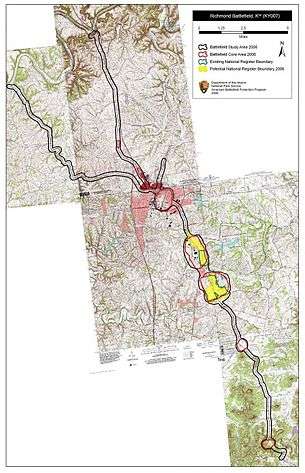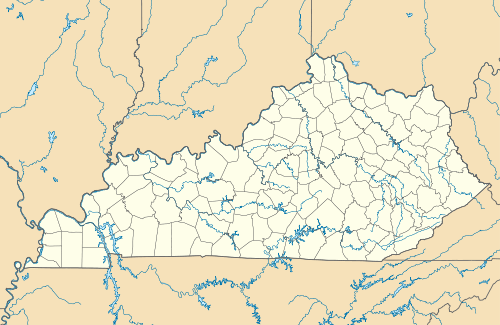Battle of Richmond
The Battle of Richmond, Kentucky, fought August 29–30, 1862, was a stunning Confederate victory by Major General Edmund Kirby Smith against Union major general William "Bull" Nelson's forces, which were defending the town. It was the first major battle in the Kentucky Campaign. The battle took place on and around what is now the grounds of the Blue Grass Army Depot, outside Richmond, Kentucky.

Background
In the fall of 1862, two Confederate armies moved on separate paths into Kentucky, hoping to put the shadow Confederate government of Kentucky into power, threaten Union cities along the Ohio River, and recruit men to join the Confederate Army. First to move was Smith, leading the Confederate Army of Kentucky, whose ideas provided the initiative for the offensive. General Braxton Bragg, commanding the Army of Mississippi, moved on a roughly parallel track to the west. Smith departed Knoxville on August 13, Bragg left Chattanooga on August 27.
Opposing forces
Union
Confederate
Battle
Brigadier General Patrick Cleburne led Smith's advance, with Colonel John S. Scott's cavalry out in front. The Confederate cavalry, while moving north from Big Hill on the road to Richmond, Kentucky on August 29, encountered Union troopers and began skirmishing. After noon, Union artillery and infantry joined the fray, forcing the Confederate cavalry to retreat to Big Hill.[3]
At that time, Brigadier General Mahlon D. Manson, who commanded Union forces in the area, commanded a brigade to march to Rogersville, Kentucky towards the rebels. Fighting for the day stopped after pursuing Union forces briefly skirmished with Cleburne's men in the late afternoon. That night, Manson informed his superior, Bull Nelson, of his situation, and he ordered another brigade to be ready to march in support when required.[3]
Smith ordered Cleburne to attack in the morning and promised to hurry reinforcements (Brigadier General Thomas J. Churchill's division). Cleburne started early, marching north, passed through Kingston, dispersed Union skirmishers, and approached Manson's battle line near Zion Church. As the day progressed, additional troops joined both sides. Following an artillery duel, the battle began, and after a concerted Confederate attack on the Union right, the Union troops gave way. Retreating into Rogersville, they made another futile stand at their old bivouac.[3]
By now, Smith and Nelson had arrived and taken command of their respective armies. Nelson rallied some troops in the cemetery outside Richmond, but they were routed.[3]
Aftermath
Nelson and some of his men escaped, but the Confederates captured over 4,300 Union troops. Total casualties were 5,353 (206 killed, 844 wounded, and 4,303 captured or missing) on the Union side, and 451 (78 killed, 372 wounded, and one missing) for the Confederates.[2] The way north towards Lexington and Frankfort was open.[3]
Civil War historian Shelby Foote remarked that Smith "accomplished in Kentucky the nearest thing to a Cannae ever scored by any general, North or South, in the course of the whole war."[4]
Battlefield preservation
Battle of Richmond Historic Areas | |
  | |
| Nearest city | Richmond, Kentucky |
|---|---|
| Area | 214 acres (87 ha) |
| NRHP reference No. | 94000844[5] |
| Added to NRHP | August 22, 1996 |
The Civil War Trust (a division of the American Battlefield Trust) and its partners have acquired and preserved 365 acres of the Richmond Battlefield.[6]
The Mt. Zion Christian Church, which served as a hospital during the battle and has cannonballs embedded in its brick walls, is listed on the National Register of Historic Places.[7]
Two discontinuous areas totalling 214 acres (87 ha) were listed on the National Register of Historic Places as Battle of Richmond Historic Areas in 1996.[5] These included four contributing buildings.[8]
See also
Notes
- Values of Union strength given by various sources are: 6,500 engaged by Livermore (1900) (p. 89), 16,000 by Bodart (1908) (p. 526); for Confederate strength: 6,850 engaged by Livermore (1900) (p. 89), and 8,000 by Bodart (1908) (p. 526).
- Eicher, p. 316.
- NPS Archived February 17, 2005, at the Wayback Machine
- Foote, p. 650.
- "National Register Information System". National Register of Historic Places. National Park Service. July 9, 2010.
- American Battlefield Trust "Saved Land" webpage. Accessed May 22, 2018.
- S. Willis; H. Powell (1986). "Kentucky Historic Resources Inventory: Mt. Zion Christian Church". National Park Service. Retrieved January 9, 2018. With six photos from 1986.
- Helen C. Powell (March 30, 1994). "National Register of Historic Places Registration: Battle of Richmond Historic Areas / Ma-90, Ma-91, Ma-92, Ma-93". National Park Service. Retrieved February 10, 2018. With four photos.
References
- National Park Service battle description
- CWSAC Report update – Kentucky
- Bodart, Gaston (1908). Militär-historisches kreigs-lexikon, (1618–1905). Stern.
- Eicher, David J., The Longest Night: A Military History of the Civil War, Simon & Schuster, 2001, ISBN 0-684-84944-5.
- Foote, Shelby, The Civil War: A Narrative, Vol. 1: Fort Sumter to Perryville, Random House, 1958, ISBN 0-394-49517-9.
- Livermore, Thomas Leonard (1900). Numbers and Losses in the Civil War in America, 1861–1865. Houghton, Mifflin and company.
Further reading
- Castel, Albert (1993) [1st pub. 1968]. General Sterling Price and the Civil War in the West (Louisiana pbk. ed.). Baton Rouge; London: Louisiana State University Press. ISBN 0-8071-1854-0. LCCN 68-21804.